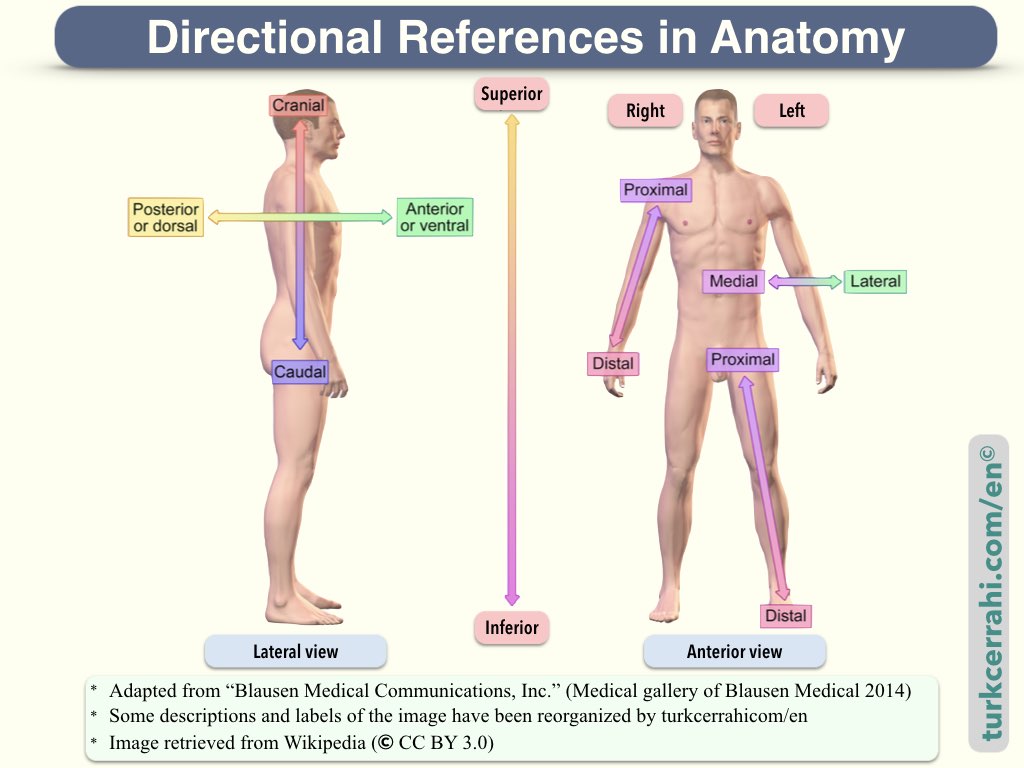Distal
In medicine or anatomy, “distal” refers to a location that is farther away from the center of the body or the point of origin. Anatomically, “distal” is also far from a reference point, attachment point, or median line.
Distal is the antonym of “proximal.” In contrast, the term “proximal” is used to describe a location that is closer to a reference point, origin, attachment point, or median line of the body.

Image retrieved from Wikipedia on 03 July 2023 under Creative Commons Attribution-ShareAlike 3.0 Unported. By Bruce Blaus (Author), Medical gallery of Blausen Medical 2014, Image’s Page
For example, “distal” is often used to describe the part of a limb (such as an arm or a leg) that is farther away from the torso. So, the fingers of the hand are considered “distal” to the wrist, while the shoulder is considered “proximal” to the elbow.
The mouth is considered the most proximal part of the digestive system, while the anus is considered the most distal. This is because the digestive system begins with the oral cavity, where food is ingested and begins to be mechanically broken down, and ends with the anus, where waste products are eliminated from the body.
In the context of surgery, a distal gastrectomy refers to the removal of the distal (lower) portion of the stomach, leaving the proximal (upper) portion intact.
Distal pancreatectomy is a surgical procedure that involves the removal of the distal (lower) part of the pancreas, which includes the tail and part of the body of the pancreas. The head of the pancreas, which is located closer to the duodenum, is considered the proximal part.
Distal and proximal are not uniformly used in the clinical literature when referring to certain structures such as the superior and inferior vena cava, internal jugular vein, common bile duct, and pancreatic duct. According to the author, the direction of fluid flow in hollow structures may cause confusion when describing them as distal or proximal.
Here are the proper uses of distal and proximal in various anatomical structures.
Common Bile Duct: The proximal part of the common bile duct is near the liver, where it is formed by the junction of the cystic duct and the common hepatic duct. The distal part of the common bile duct is near the duodenum, where it joins with the pancreatic duct to form the hepatopancreatic ampulla, also known as the ampulla of Vater, before entering the duodenum at the major duodenal papilla.
Pancreas: The proximal pancreas refers to the head and body of the pancreas, which are closer to the duodenum and adjacent to the common bile duct. The distal pancreas refers to the tail of the pancreas, which extends to the left side of the abdomen and is adjacent to the spleen. A distal pancreatectomy involves the surgical removal of the distal part of the pancreas.
Main Pancreatic Duct (duct of Wirsung): The proximal part of the main pancreatic duct is at the head of the pancreas, where it joins the common bile duct to form the hepatopancreatic ampulla (also called the ampulla of Vater) before entering the duodenum. The distal part of the main pancreatic duct is at the tail of the pancreas.
Inferior vena cava (IVC): The proximal IVC refers to the part of the vein that is closer to the heart (right atrium), while the distal IVC refers to the part of the vein that is farther away from the heart.
Superior vena cava (SVC): The proximal SVC refers to the part of the vein that is closer to the heart (right atrium).
Proximal versus Distal Splenorenal (Warren) Shunt: When we examine the nomenclature of proximal and distal splenorenal shunts, we see that the terms “proximal” and “distal” are used in reverse. In fact, in a distal splenorenal shunt, the proximal side of the splenic vein is anastomosed to the left renal vein, while in a proximal splenorenal shunt, the distal side of the splenic vein is anastomosed to the left renal vein.
To comprehend how this nomenclature was established, we need to know the definition given by Dr. Warren and colleagues in their 1967 publication.
- Technique of Distal Splenorenal Shunt and Gastrosplenic Isolation: “The splenic vein at its junction with the inferior mesenteric vein is doubly clamped, divided and the proximal end is oversewn. The left renal artery is temporarily occluded and a segment of renal vein is isolated between vascular clamps. An incision approximately 2.5 cm. long is made in the superior aspect of the renal vein and the distal end of the cut splenic vein is beveled appropriately “ (W D Warren, R Zeppa, J J Fomon, Selective trans-splenic decompression of gastroesophageal varices by distal splenorenal shunt, Ann Surg 1967 Sep;166(3):437-55, link)